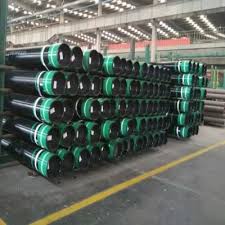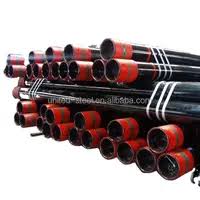1.What is casing drilling?
Steel casing drilling uses octg casing instead of drill pipe to apply torque and bit pressure to the drill bit to achieve drill bit rotation and drilling. The entire drilling process no longer uses drill pipes, drill collars, etc. The drill bit is fished with a wire rope, and the drill bit is raised and lowered in the casing, which means that the drill bit and drilling tools can be replaced without lifting the drill, which reduces accidents such as tripping, blowouts, stuck drills, etc., improves drilling safety, and reduces costs.In the 1950s, some people envisaged using octg casing instead of drill pipe to complete drilling operations. However, due to the limitations of the technology and equipment conditions at the time, it was difficult to realize it. In the 1990s, the continuous development of oil extraction technology was promoted due to the great development of new technologies, new materials, and electronic technology. Many new drilling techniques, tools, and equipment emerged, and casing drilling technology was once again proposed.

2.Characteristics of casing drilling
Drilling with casing pipe has obvious advantages over conventional drill pipe drilling. It is a technological revolution in drilling engineering and can bring huge economic benefits to oil field operators. Casing drilling has the following characteristics:(1) Standard oil well casing is used for casing drilling and drilling and casing running operations are carried out simultaneously;
(2) The bottom hole assembly is installed at the lower end of the casing string, and a wire rope can be used to remove it through the inside of the casing quickly. During the removal process Continuous circulation of mud can be maintained;
(3) During the entire drilling process, the casing is kept straight to the bottom of the well to improve well control;
(4) The casing is only drilled into the formation in one direction and no longer pulled out. Unless the well is confirmed to be dry after drilling, the last section of casing string may have to be pulled out;
(5) Drilling with casing can use many existing drilling technologies, such as directional drilling, cement injection, logging, coring and well testing;
(6) The main difference between the application of these technologies and the original ones is that they no longer rely on drill pipes, but rely on wire ropes to replace drill bits;
(7) Casing pipe drilling is performed using standard oilfield casing. The only difference is that the casing coupling or thread needs to be modified to provide the torque required for drilling.

3.Scope of application of drilling with oil casing
Casing drilling is suitable for oil areas with relatively stable oil reservoir depth: since casing drilling is completed directly with cementing and perforation for oil production, there is no logging technology to measure the reservoir depth and uate the reservoir development. Therefore, it is required that the development of the oil layer and the burial depth must be stable so that the depth design of casing drilling can be guaranteed.Suitable for areas with stable development and small formation inclination: Since well deviation is inevitable during casing drilling, the effect of well deviation results in differences in the completed drilling depth and vertical depth. The greater the well deviation, the greater the difference. The size of formation inclination, the development of fractures, faults, etc. play an important role in affecting well deviation. Therefore, the formation inclination angle of the designed casing drilling area should be small, and cracks and faults should be undeveloped or underdeveloped, which is beneficial to the control of well deviation during casing drilling.
4.Precautions for drilling with casing pipe
(1) Well deviation control problemDuring the casing drilling process, well inclination control is the primary issue, and well inclination directly affects the vertical depth of the drilled wellbore. In other words, whether the buried depth of the oil layer and the actual depth drilled can be stably consistent depends on the well inclination.
Control the drilling weight within a reasonable range of 10-30KN. Since there are no drill collars and centralizers in the casing string during casing drilling, during the pressurization process, the casing string is easily bent under pressure, causing well deviation.
Therefore, the drilling pressure must be strictly controlled during drilling. From this perspective, choosing PDC bits is more suitable for casing drilling. The turntable speed is controlled at a low speed, generally within 60-120r/min. The low-speed drilling process is beneficial to the stability of the casing string and the control of well deviation.
The derrick base is installed straight to ensure that the drilling wellhead is vertical, and inclination monitoring is strengthened during the process. On the one hand, it is easy to understand and control the lower well inclination control situation, and on the other hand, it is easy to calculate the vertical depth.
(2) Casing protection issues
After casing drilling is completed, the casing string remains directly in the well, so casing protection is important. Use casing thread glue. The casing is sealed by threads.
During the casing drilling process, special glue for casing must be used to ensure that the threads are sealed reliably and the connection is firm. Casing anti-corrosion issues. When the casing is drilled, the outer wall is worn due to rotation, and the The outer anti-corrosion layer easily falls off. The inner wall is eroded by drilling fluid, and the inner anti-corrosion layer is also eroded.
Measures to prevent casing corrosion
①The casing used for drilling is required to have internal and external coatings for anti-corrosion;
②Low-speed drilling with low bit weight is used during drilling, which is beneficial to reducing the wear of the outer wall of the casing;
③The drill bit water hole size is increased to reduce the wear and tear of the outer wall of the casing. The pump pressure in the pipe reduces the erosion of the inner wall of the casing by drilling fluid.
Previous:Helical pipe pile
Next:Intermediate casing









